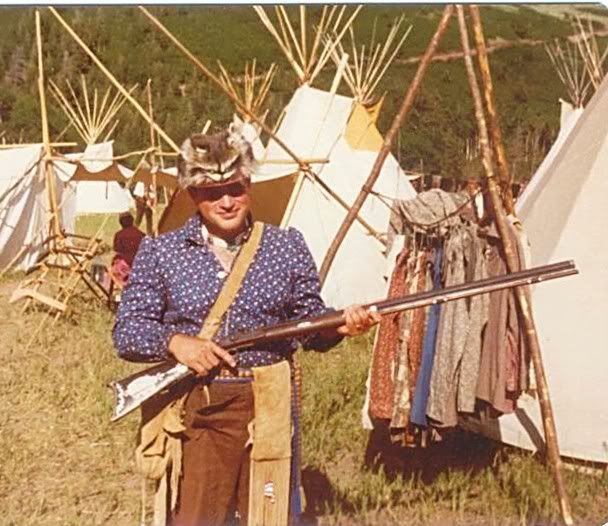50cal.cliff,
The link to
(A) EXTREMELY SCARCE & HIGH CONDITION SAMUEL HAWKEN PERCUSSION RIFLE at Proxibid you posted above is a mid- to late-1850s rifle.
I saw it at the Colorado Gun Collectors Show here in Denver a few years ago. The auction company, Morphy Auction, had it on display at their table. The barrel, breech & tang, and lock are of the same dimensions and style as on the Kit Carson Hawken in Santa Fe, NM and the Jim Bridger Hawken in Helena, MT. The stock is the same profile, too. The butt plate and nose cap may have been cast from the same patterns as used for the Carson and Bridger rifles, just cast in brass rather than iron. The big difference is the trigger guard, obviously. This brass mounted rifle could have been made at the same time or a little later than the Carson and Bridger rifles.
By 1855, Sam Hawken had semi-retired from the gun business and let his son, William, take over operations of the shop. William Hawken and Tristian Campbell began advertising in 1855 that they were doing business as Hawken & Campbell next door to Sam's old stand. They advertised repairs and "Mountain and California Rifles made to order" through 1855 and into 1856. On February 29, 1856 a notice ran in the paper that William S. Hawken and Tristiam Campbell were dissolving their partnership. In March of 1857, William Hawken began advertising under his own name at the old address of his father's stand. These ad ran until August 15, 1857 when a notice ran that William Hawken had essentially declared personal bankruptcy and was settling outstanding claims against him.
William continued to be listed in business directories as a gunsmith, but not as a proprietor. Sam also was occasionally listed as a gunsmith, but apparently not associated with his son. The last listing in a directory for Sam as a gunsmith was in 1859.
In that year, Sam decided he want to see the Mountains and try his hand in the Colorado gold fields. He traveled from St. Louis to Denver via the Santa Fe Trail for most of the way, then up the Trappers Trail from the vicinity of present day Pueblo, CO to Denver. Sam worked in the gold fields for six or so weeks before coming to the conclusions that the best sources for gold had already been claimed, then went back to Denver and opened a gun shop in Auraria. In 1860, his son, William, and old employee Tristian Campbell made the trek from St. Louis to Denver and joined Sam in the gun shop.
The brass mounted rifle that sold at Morphy Auction could have been made before 1855 or possibly up to the time that Sam left for Denver in 1859. It seems that Sam was only working part-time as a gunsmith from 1855 to 1859, but still could have made some rifles in this period.
The style of half stock rifle like the brass mounted Hawken that sold at Morphy Auction continued to be popular from the 1850s through the rest of the muzzleloader era. Sam was no longer making them, but other gunsmiths all across the country were. Some were large caliber plains rifles but most were small caliber sporting and target rifles, even though the heavy barrels were still present.
I second the post from Rich Pierce about the advice that he got from "a top builder of Hawken rifles...:
Don’t bother to build a generic Hawken rifle. Replicate an original."
That's easier said than done based on the parts that are currently available. The Hawken Shop in Oak Harbor, WA has an authentic kit as most of the metal parts were cast from an original S. Hawken rifle. Track's Jim Bridger Hawken kit is basically the same as the late S. Hawken rifles that GRRW was making from the end of 1976 until they closed in Sept 1980. These in turn are close but not exact copies of the Jim Bridger Hawken in the Montana Historical Society collection. Don Stith has kits that are very authentic, but I don't know if his medical condition is allowing him to attend to his business.
Beyond these kits you are on your own to assemble parts and try to copy an original as closely as possible. Other Hawken kits like Track's Kit Carson kit and Pecatonica's Hawken kits are mere approximations or representations of a Hawken rifle.
A couple of rifles assembled from Hawken Shop Hawken kits (from the Art Ressel period).
 I found it doing a search for information on original Halfstosk This Hawken. it is listed as, (A) EXTREMELY SCARCE & HIGH CONDITION SAMUEL HAWKEN PERCUSSION RIFLE
I found it doing a search for information on original Halfstosk This Hawken. it is listed as, (A) EXTREMELY SCARCE & HIGH CONDITION SAMUEL HAWKEN PERCUSSION RIFLE I found it doing a search for information on original Halfstosk This Hawken. it is listed as, (A) EXTREMELY SCARCE & HIGH CONDITION SAMUEL HAWKEN PERCUSSION RIFLE
I found it doing a search for information on original Halfstosk This Hawken. it is listed as, (A) EXTREMELY SCARCE & HIGH CONDITION SAMUEL HAWKEN PERCUSSION RIFLE













